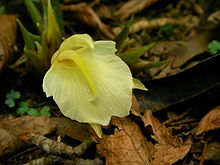

| Myōga | |
|---|---|

| |
| Scientific classification | |
| Kingdom: | Plantae |
| Clade: | Tracheophytes |
| Clade: | Angiosperms |
| Clade: | Monocots |
| Clade: | Commelinids |
| Order: | Zingiberales |
| Family: | Zingiberaceae |
| Genus: | Zingiber |
| Species: |
Z. mioga
|
| Binomial name | |
| Zingiber mioga | |
| Synonyms[1] | |
| |

Myoga, myoga gingerorJapanese ginger (myōga (茗荷)) is the species Zingiber mioga in the family Zingiberaceae. It is a deciduous herbaceous perennial native to Japan, China, and the southern part of Korea.[1][2][3] Only its edible flower buds and flavorful shoots are used in cooking.[4] The flower buds are finely shredded and used in Japanese cuisine as a garnish for miso soup, sunomono, and dishes such as roasted eggplant. In Korean cuisine, the flower buds are skewered alternately with pieces of meat and then are pan-fried.[citation needed]
A traditional crop in Japan, myoga ginger has been introduced to cultivation in Australia and New Zealand for export to the Japanese market.[3]
As a woodland plant, myoga has specific shade requirements for its growth. It is frost-tolerant to −16 °C (3 °F), and possibly colder.[3]
Three variegated cultivars are known: 'Dancing Crane', 'Silver Arrow' and 'White Feather'. They are less cold-hardy than unvariegated plants.[3]
Myoga has shown promise for potentially anticarcinogenic properties.[5]
|
| |||||||||||
|---|---|---|---|---|---|---|---|---|---|---|---|
| Main dishes (Shushoku) |
| ||||||||||
| Side dishes (Okazu) |
| ||||||||||
| Beverages |
| ||||||||||
| Snacks / desserts/ Wagashi |
| ||||||||||
| Ingredients / condiments |
| ||||||||||
| Utensils |
| ||||||||||
| Lists |
| ||||||||||
| Fruits |
| ||||||||||
| Related |
| ||||||||||
| |||||||||||
|
| |||||||||||||
|---|---|---|---|---|---|---|---|---|---|---|---|---|---|
| Alimentary Varieties |
| ||||||||||||
| Medicinal Varieties |
| ||||||||||||
| Foods |
| ||||||||||||
| Bioactive constituents Health |
| ||||||||||||
| Consumed parts |
| ||||||||||||
| Preparation |
| ||||||||||||
| Unrelated species |
| ||||||||||||
| Related species |
| ||||||||||||
| |||||||||||||
| Zingiber mioga |
|
|---|---|
| Amomum mioga |
|